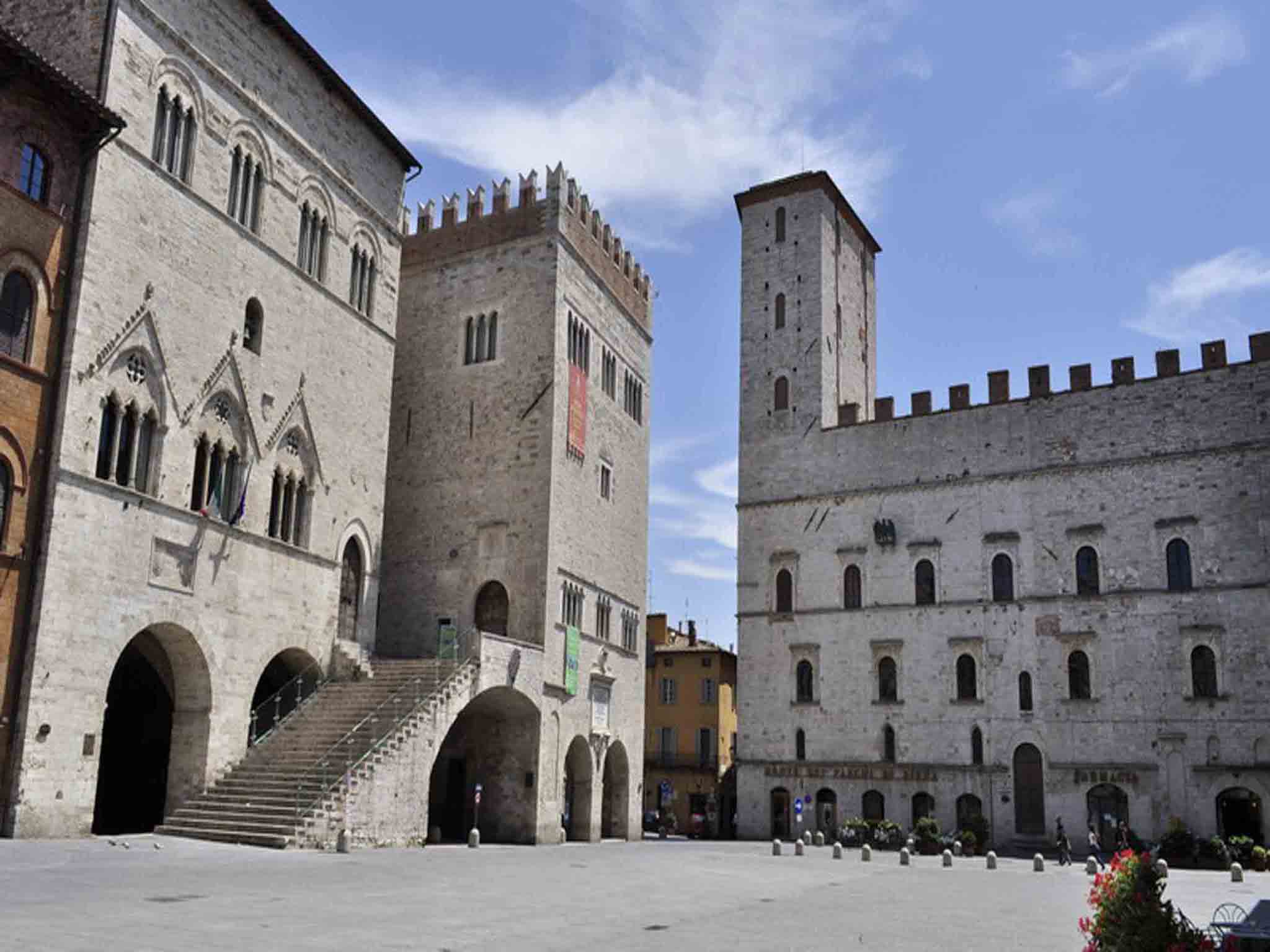Umbria is made up of hundred of small towns, often hidden between hills and cliffs. This route leads us from Todi to Montefalco, through Acquasparta, Massa Martana, Giano dell’Umbria, Bevagna, Spello and Foligno.
 Todi: San Fortunato and Piazza del Popolo.
Todi: San Fortunato and Piazza del Popolo.
Just outside Todi, Santa Maria della Consolazione is a XVI century temple, whose perfect architecture has gained it the name of “Bramante’s church”. It is also the place where the feast of Virgin Mary is celebrated, on the 8th of Semptember, with the participation of the whole town. Giardini Oberdan offer an outlook on Tevere’s Valley, from the small town of Montecastello di Vibio to Perugia, visible in the brightest days, about 25 miles away. We enter Todi’s center through via Ciuffelli, and get to the majestic flight of steps culminating in the temple of San Fortunato. Its tall and bright interior is characterized by the aisles and the nave of equal height, according to a Gothic model called Hallenkirche (“hall church”), quite rare in Umbria. In the crypt, a marble sarcophagus contains the relics of San Fortunato and other four patron saints; on the left, the tomb of the poet and mystic Jacopone da Todi. The heart of the town is Piazza del Popolo. On the two sides of the square, the Cathedral is the symbol of religious power, whereas the Palazzi Comunali (1213-1370) embody the secular authority. The Cathedral of Santa Maria Annunziata stands on the top of a large flight of stairs. Its facade was struck by lightning at least four times, causing several damages to the rose window, the bell tower and the wood portal, which retains just two of its original panels. Like many Romanesque churches, the interior, with its dim lighting, seems to invite to prayer and contemplation. The Bishop’s Palace was built in 1593 and offers many finely decorated rooms and halls.

 From Dunarobba to Massa Martana.
From Dunarobba to Massa Martana.
Heading towards San Damiano and Acquasparta (SS 3 bis), we get to Dunarobba in twenty minutes. Its Fossil forest is one out of three cases in the whole world, where an ancient forest has been mummified, instead of petrified. Some of the trees are still standing, reaching 50 feet in height and 10 feet in diameter. The Benedictine Abbey of Saint Fidenzio and Terenzio, near Massa Martana (SS 3 bis towards Villa San Faustino, SS 316) was, in the Middle Ages, one of Umbria’s most powerful ones, and retains a typically Romanesque architecture. A twenty minute’s trip (SS 316 towards Giano dell’Umbria) leads us to the Abbey of San Felice. Built close to a branch of Via Flaminia, the major Roman thoroughfare crossing Umbria, it belongs to a series of Romanesque churches, scattered between Spoleto and Bevagna, showing similar architectural features.

 Bevagna and Spello.
Bevagna and Spello.
It takes less than half an hour from Giano dell’Umbria to Bevagna (SS 316 towards Bastardo, Cantinone), one of the most pictoresque towns in Umbria, with its perfectly preserved medieval structure inside the city walls. A few miles from Bevagna, in Capro (SP 403 towards via Alcide De Gasperi, vocabolo Capro) the small but deep pond of Aiso (or Abisso) is liked to a legend, according to which it was originally the barnyard of a peasant, punished for having worked during the feast of Sant’Anna. Nearby, the Monastery of the Annunziata (also known as Sant’Ansovino) and the towns of Cantalupo, Limigliano and Collemancio also deserve a visit. 10 miles from Bevagna, at the feet of Mount Subasio, Spello offers the marvellous frescoes of Pinturicchio and Perugino in the Church of Santa Maria Maggiore, and the romanesque church of San Claudiano.
 The Valley of Menotre: Abbeys and Hermitages.
The Valley of Menotre: Abbeys and Hermitages.
The Valley of Altolina (from Foligno towards Colfiorito; SS 3, towards Belfiore, Altolina), majestic and untouched, is one of the most charming areas of Umbria. The massif of Sasso di Pale (3076 feet) offers a rich wildlife, the karstic caves of Pale and an impressive, 500-feet tall waterfall. The Hermitage of Santa Maria Giacobbe clutches directly at the rocks of the mountain. On our road back to Foligno (SS77 towards Colle di San Lorenzo, Serra Bassa, via Sassovivo), we reach the Abbey of Sassovivo, one of the richest in Umbria, recently restored after the heartquake of 1997. We get back to Foligno, and then to Montefalco.


Comment (0)